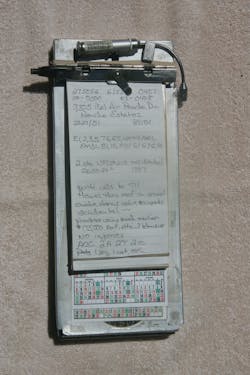The Fire PIO: Handling Information At Emergency Incidents
One of the main duties of a fire department public information officer (PIO) is to disseminate information. To do that correctly, the PIO will need to gather information first and ensure it is accurate. When the media covers a story, they need to know who, what, when, where, why and how. When you gather information, you also need to address each of these areas.
To keep track of what information I gather, I write it down in a notebook. This way, I have a record of it that I may use again in the future. I use what is called a “reporter’s notebook,” which can be purchased at any office supply store. I keep my notebook on a “citation holder,” the same type of citation holder police officers use to write traffic citations. It is made of metal, is the same size as the reporter’s notebook and has a compartment to store extra pens, notes you need to have on scene and business cards to pass out to the media.
Information gathering starts when you first receive notification of an incident. Whether you receive a phone call, pager alert or email, once you are notified, start gathering information. Information I immediately write down includes the address of the incident and the time and nature of the call. This way, when reporters request information from you while enroute to the scene or just after you arrive on scene, you have some information to provide.
Once on scene, meet with the incident commander to find out what you can. You can also talk to crews on scene, bystanders, witnesses, occupants involved, medical personnel and fire investigators. I talk to as many people as I can to get as much information as possible about the incident.
Collecting information
Important information to gather at an incident includes:
• Time and date of the incident
• Incident or report number
• Address of the incident (verify this; many times, the address given at dispatch is the caller’s address and not the correct address of the actual incident)
• Name of business, building, subdivision, complex
• Nature of the call (fire, rescue, disaster, EMS response, etc.)
• What is happening
• Who is involved (who is affected by the incident)
• Type of building (single-family residential, mobile home, outbuilding)
• Size of the building ( one story, two story, square footage if possible)
• Resources are being used (number of apparatus, number of firefighters)
• Number of alarms
• Whether fire safety equipment played a role (smoke alarms, sprinklers, fans)
• Any information about pets if involved
• Cause of the incident if determined
• Damage estimates and/or amount of property saved
• Support agencies assisting (American Red Cross, Salvation Army)
• Casualties to civilians (injuries, fatalities)
• Casualties to fire service personnel
• Number of people displaced
Check your facts
The PIO receives and disseminates information while working an incident. Sometimes, witnesses or even the media will provide you with information that is critical to the incident and that information should be provided to the incident commander. I’ve worked incidents in which the media provided information to me on scene that assisted fire investigators in determining a cause, even the arrests of arson suspects.
As a professional, ensure that all information is absolutely correct to the best of your ability. Don’t rely on second-hand information or hearsay. Ask questions and check things out yourself. Many times, that means walking around the incident, making observations personally and asking questions.
Make sure confidential information is kept where no one can access it who is not authorized. I usually write on the other side of the page where I am putting my main information as outlined above so it cannot be seen. I also keep a rubber band on the bottom of my reporter’s notebook so the page I am working on cannot flip over to reveal confidential information. Never leave your notebook anyplace where someone else can get it and access confidential information. Always keep it in a safe place. When the incident has terminated and you return to quarters to draft your media release or give interviews later, you have all the information you need at your fingertips.
I have kept all of my reporter’s notebooks and often reference them to gather information about past incidents. I have been subpoenaed to appear in court or asked to give dispositions because of statements I made during interviews or at the scenes of incidents. Many times, those requests come months or even years later and it is difficult to remember what went on. By having your notes, you can refresh your memory.
